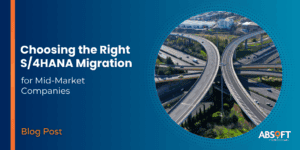The upstream oil and gas companies operating in Scotland and Norway are major SAP users. Absoft completed one of the first SAP R3 implementations for Total E&P in Aberdeen in 1992, and have focussed on SAP ever since. Many SAP teams in Aberdeen and further afield are now wondering what SAP HANA can do for them.
SAP HANA is SAP’s new database management system (DBMS) that uses in-memory computing, column storage, compression and optimised analytical processing to provide an extremely fast database platform. HANA’s real strength is in fast read performance, allowing better reporting in more detail over more data than ever before.
HANA is where SAP are focussing their innovation, and their new products and developments generally make use of the new features of HANA to deliver added value. SAP’s new generation Business Suite, S/4 HANA, is the latest product to exploit the features of the HANA database.
HANA is taking off as more and more customers are already running it in production so it’s time to be considering it if you are part of a SAP team.

A major challenge for HANA in the oil and gas industry so far is that a lot of high-profile case studies and business cases have focussed on crunching large quantities of business data, such as retail sales data, to give a company new insights and a competitive edge over competitors. The upstream oil and gas industry simply doesn’t have this volume of retail data to crunch.
The cost saving measures currently prevalent in the industry mean the HANA business case must be strong. Currently, we feel the business case is one of many smaller benefits that add up to a compelling whole.
For example, if you migrate your SAP ERP system to use a HANA database, you can gain the following advantages:
- SAP Simple Finance, offering faster period close and reduced debtor days to improve your business, as well as less user training requirement and streamlined approvals to cut costs in your finance department.
- Direct real-time reporting on your ERP data with SAP HANA Live, meaning you can report on current data without waiting for it to load into BW, and possibly can work without BW at all.
- Simplification and decreased system footprint. HANA decreases both the size and complexity of your current system, through compression and reduced warehousing of data, and through system consolidation by reducing your need for extra reporting solutions.
- A step towards S/4 HANA. S/4 HANA is the next generation Business Suite from SAP. S/4 HANA runs only on the HANA database, and the first step to migrating your current systems to S/4 HANA is to migrate them to a HANA database.
SAP are also working on using HANA to crunch more data that is relevant to oil and gas, such as a partnership with Shell to develop a Well and Reservoir Facility Management (WRFM) system, and products like Predictive Maintenance that bring the benefits of HANA to your plant operations. Such developments could give you a real competitive edge over competitors.

One of the challenges of running SAP in Aberdeen for many organisations is the need to comply with a wider corporate SAP strategy, often dictated by a head office in another region. The lack of freedom to choose a database platform or install new packages into the SAP system can restrict innovation locally.
To avoid restrictions, we feel an excellent option is to look at sidecar implementations of HANA. HANA can be installed standalone, and trigger-based data provisioning tools are used to load data from ERP or elsewhere into the HANA database, where real-time reporting with SAP HANA Live can take place whilst your ERP system remains unchanged.
The first option to load your data into a standalone HANA system in real-time is SAP Landscape Transformation which connects directly to SAP and therefore does need an additional component installed. It notably does not support Joint-Venture Accounting data which is very limiting for oil and gas.
Sybase Replication Server is a good option that connects directly to the database of your SAP systems to copy data to HANA, meaning less changes are required to SAP. Both Sybase Replication Server and SAP Landscape Transformation can be licensed as part of your HANA license.
It’s a widely held belief that our future depends on continuing the innovation that the North Sea has become famous for, and making a sidecar implementation of SAP HANA is an excellent example of how to facilitate innovation within a large, global and conservative organisation.

If you are interested in looking at how you can deploy SAP HANA in your organisation, first consider the functional business case. Product demos are available from Absoft if you are interested in specific areas.
The process to choose a deployment option, be it a full migration to SAP HANA or sidecar, and to understand any technical business case for HANA, are best addressed in a road map exercise. Completing a roadmap will help you understand costs and benefits for all options, and to develop a programme of work that will ensure a successful and fully supported transition.










